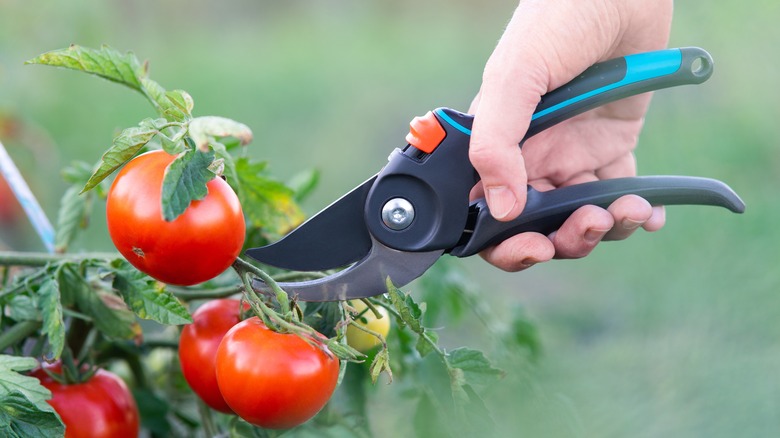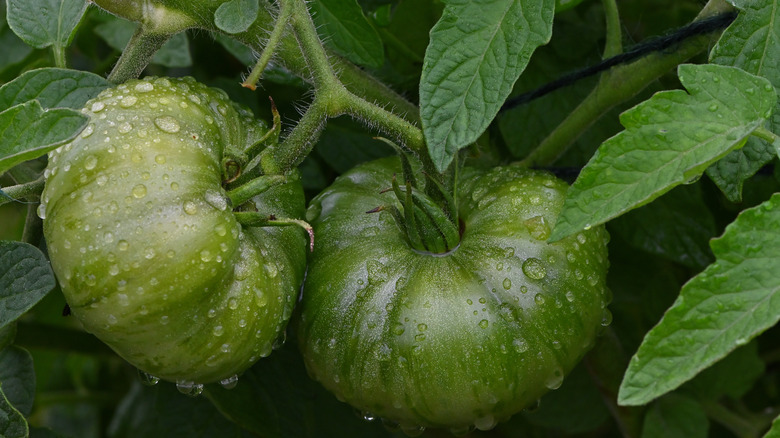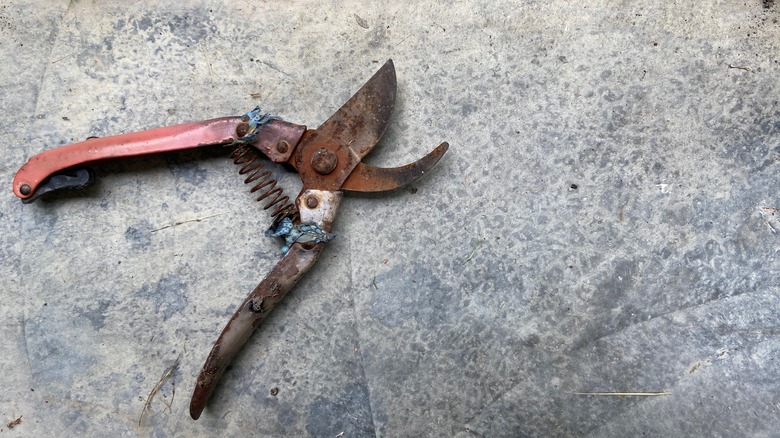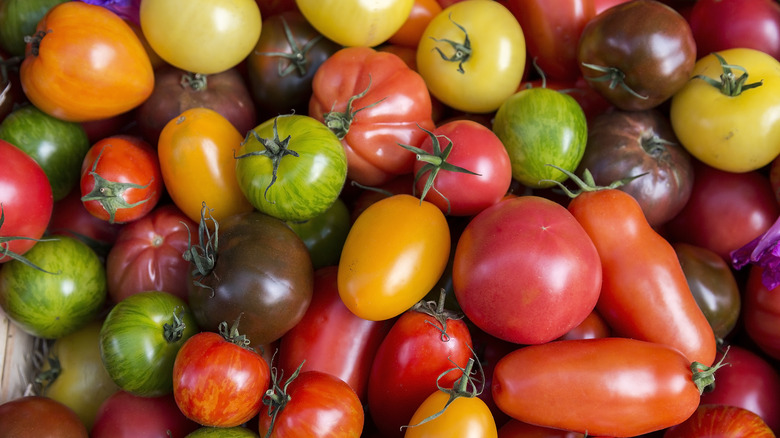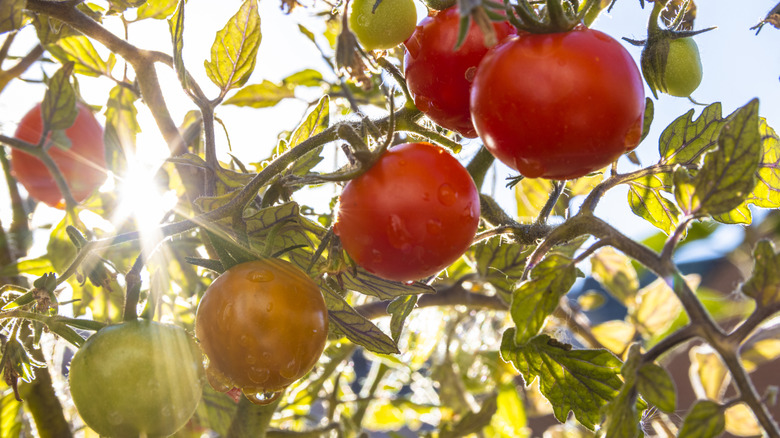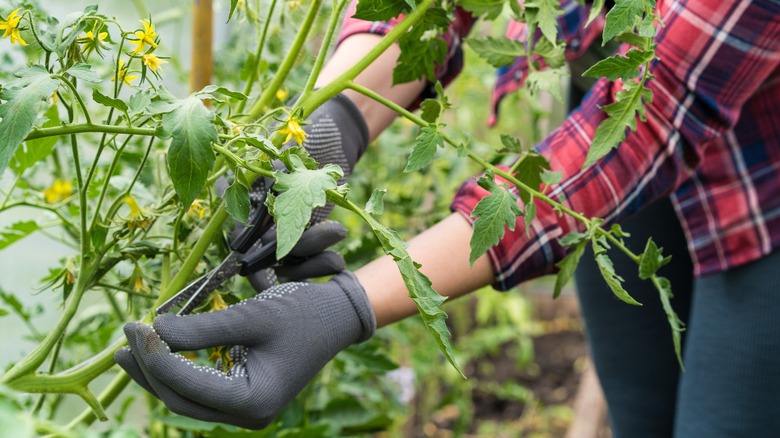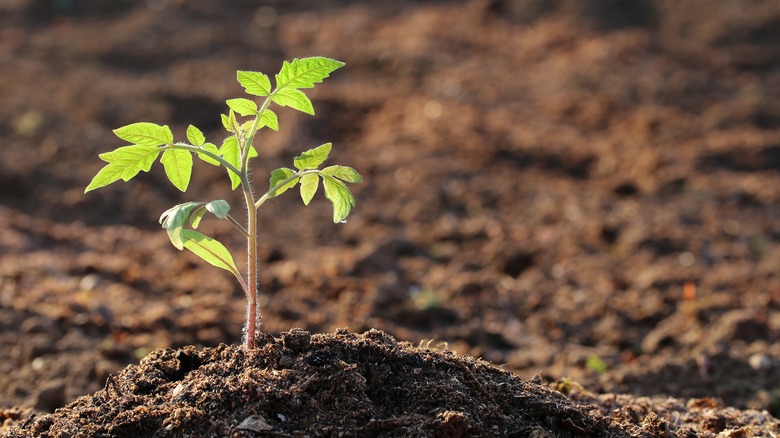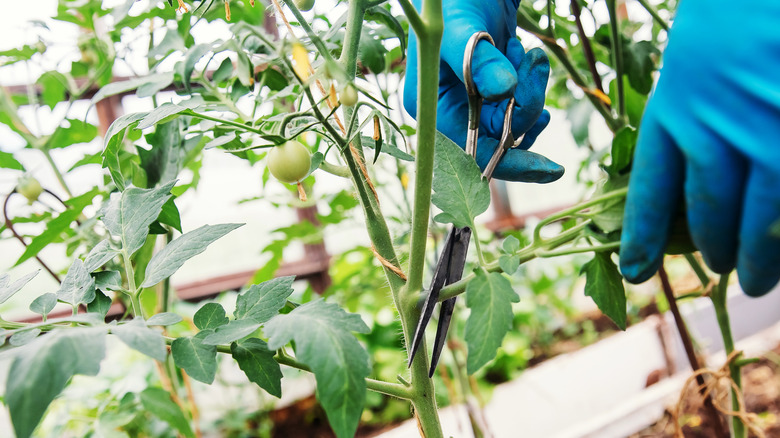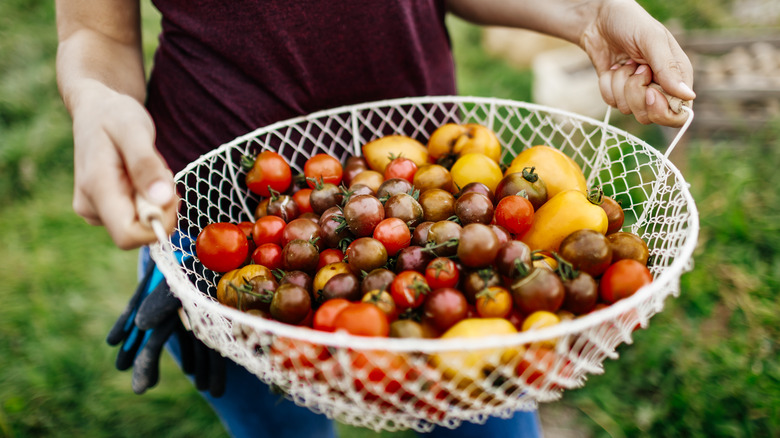Crucial Mistakes To Avoid When Pruning Tomatoes
Whether you like them sweet or savory, red or purple, bite-size or in slices, there's a tomato for almost everyone. And with over 10,000 varieties, this versatile fruit can be used in countless culinary creations. It's a beloved staple in the veggie plots of novice and master gardeners alike. They're relatively easy to grow, as their basic needs consist of full sun (eight hours per day), healthy soil, and support in the form of cages, trellises, or stakes.
There is one critical piece to tomato growing that guarantees the greatest output and healthiest fruit: pruning. When done correctly, you'll enjoy higher yields, faster ripening, and a tidy, robust plant. However, it's a learned technique, with room for error. So before you grab your shears, read on to learn the crucial mistakes to avoid when clipping your tomato plants. With a little practice and care, you'll be well on your way to growing the most gorgeous globes your garden has ever seen.
Pruning when the plants are wet
While a fresh rainfall can make some garden chores easier, like pulling weeds, the same is not true for pruning. In fact, if you choose to trim your tomatoes when the plants are wet, you're actually welcoming fungus and disease with open arms. Roll out the welcome mat, because it doesn't take much for those undesirable guests to make themselves at home. Fungus thrives in close, damp environments, but it does need some time to develop. By allowing moisture to enter the plants when they're already in a vulnerable state (right after pruning), you're giving pathogens a straight, obstacle-free path.
Instead, wait for the leaves to dry out completely before you grab your shears. Proper pruning will help reduce fungal problems in the long run because tidy plants are less dense, so airflow is uninhibited. This means that everything can dry out faster after it rains, and fungus won't have time to develop. If, for some reason, you absolutely must prune while the tomatoes are still wet, clean your clippers after every cut with rubbing alcohol, and then keep a close eye out for fungal problems in the coming weeks.
Using dull tools
As with any job, the right tools are crucial for completing a project with ease and efficiency. But you can't just stop at the right tool — it needs to be well-maintained, too. Using dull or rusty blades can cause serious damage to your plants because they squish the stem instead of cleanly slicing through. Repeatedly doing this will damage the stem tissue and leave your tomatoes highly susceptible to disease.
Whether you plan to use essential tools like gardening shears, scissors, or another type of clipper, opt for something handheld to allow for optimal control. Before you begin, thoroughly assess the tools. Are the blades sharp? A great way to test is by using a piece of paper — if they tear the paper, they need to be sharpened. If they cut through crisply, they're ready for your tomatoes.
Next, are they dirty or sticky? Wash off any debris with warm water and soap, then dry thoroughly. The final step is to disinfect with rubbing alcohol. You can dip the blades or wipe them, but make sure it stays on for at least 30 seconds before drying off. It's best to get into the practice of disinfecting at the start of pruning — and as you switch between plants — to reduce the spread of disease or bacteria.
Not checking your variety
Tomatoes fall into two camps: determinate and indeterminate. It's important to check your variety before you grab your clippers, because those that are determinate should not be pruned. Doing so can severely hamper fruit production or even eliminate it completely.
If they are determinate, this means they cap out at a specific height. Typically, they're compact and bush-like. Most of the fruit will mature within a month or two, and it grows on the ends of the plant's branches — hence why you shouldn't clip them. If you're interested in canning or making your own pasta sauce, this is a great choice as you'll enjoy a bountiful harvest all at once.
On the flip side, indeterminate grow ... and grow... and grow. They'll keep going until the end of the season, possibly reaching heights of 10 to 12 feet thanks to their vining behavior. Pruning is a necessary chore to prevent the plant from growing out of control. The fruits of your labor will pay off in the form of a steady harvest throughout the summer.
Pruning in the afternoon
While tomatoes certainly love ample sunshine, the intensity of those midafternoon rays can be harsh and unforgiving. Just like watering your garden at the wrong time is a big mistake, pruning during the hottest part of the day is an equally big no-no. In its vulnerable, post-trimmed state, the plant is much more likely to wilt or suffer as a result of damage inflicted by the scorching beams. In fact, 'sunscald' commonly afflicts tomatoes (most often when they're still green) that were previously shaded and then rapidly exposed to the sun, often from incorrect or overzealous pruning.
To sidestep this mistake, plan to clip and tidy your plants first thing in the morning or the early evening. If tackling your chores in the morning, make sure that any dew on the tomatoes has dried before you begin cutting. An added benefit to pruning in the early evening? It's also a great time to check for and get rid of tomato worms. They're highly active from dusk through the night, so keep an eye out for their movements as you clip, and you'll kill two birds with one stone!
Cutting the wrong stems
When it comes to pruning, your primary focus should be on suckers and leaves. Suckers are the small offshoots that appear in the axils between the main stem and branches. If they're less than two inches long, you can easily pinch them off with your fingers; no tools needed. As you're familiarizing yourself with the ins and outs of pruning, it can be easy to get a little carried away with snipping. However, a crucial mistake to avoid is cutting the main stem. If this happens, the plant may not recover.
By staying on top of suckers, you'll help keep the main stem strong and healthy. Otherwise, they'll eventually turn into full branches with their own leaves, flowers, and fruit, and pull lots of energy away from fruits on the primary stem. A good rule of thumb is to leave the first sucker closest to the ground because it is the strongest and can grow into a second stem. For leaves, focus on removing those on the lower half of the plant only, approximately the bottom foot of the stem. If you see yellow leaves anywhere, be sure to remove those as well.
Pruning too soon
Now that you know how much pruning improves the health and production of a tomato plant, you may be anxious to get to work in your flourishing vegetable garden. Sit tight, though. Doing it too soon can impact the growth of the plant or even go so far as to damage its root system. However, while it's still early in the season, you can remove any and all flowers present on the branches. This helps the plant refocus its energy on important growth instead of producing fruit too early.
Wait until it has grown at least a foot tall (aim for 12-18 inches) before you prune for the first time. This is usually around the midpoint in the season, likely late June or early July. Aim for a follow-up session every two weeks, but adjust as needed based on the varieties you've chosen, growing zone conditions, and your own personal goals for harvest.
Over pruning
Can too much of a good thing quickly turn into a bad thing? When it comes to trimming your tomatoes, the answer is a resounding yes. While we know that thinning out the leaves is beneficial for airflow (and thus reducing the chances of fungal problems), they're incredibly important as the fruit's primary defense against scorching sunshine. Overpruning causes a whole slew of issues — from making the tomatoes more susceptible to sunscald, to stressing the plant, reducing the crop, and even negatively affecting the flavor.
Never remove more than one-third of your tomato's leaves in one session. Doing so can cause so much stress to the plant that it dies. Conversely, there's no magic number for how much you should clip each time, so keep it on the low side — only a handful of leaves and suckers per sitting. This holds true even if some of your tomatoes are growing wild and scraggly. A severe trimming might be tempting, but going overboard will only cause more problems in your veggie patch.
Pruning until harvest
Ahh, after all the checking and clipping and watering and waiting, it's finally time for your first harvest! As you daydream about all the delicious things you'll whip up with your tomatoes, make sure to avoid one crucial mistake: Do not keep pruning all the way up to harvest. The reason behind it is tied to our buzzword, sunscald. By giving your plant a break from regular clipping, it allows it time to produce natural shade that protects the delicate fruit from the hot sun.
If you're on a rigid, two-week snipping schedule, you'll want to adjust it for some leeway leading up to picking time. Instead, leave a one or two-week window free before your estimated first harvest. This should give the plant enough time to muster up its defenses and protect the fruit in its final ripening stages. You'll be rewarded with vibrant, juicy, flavorful globes that are free from sun damage.
